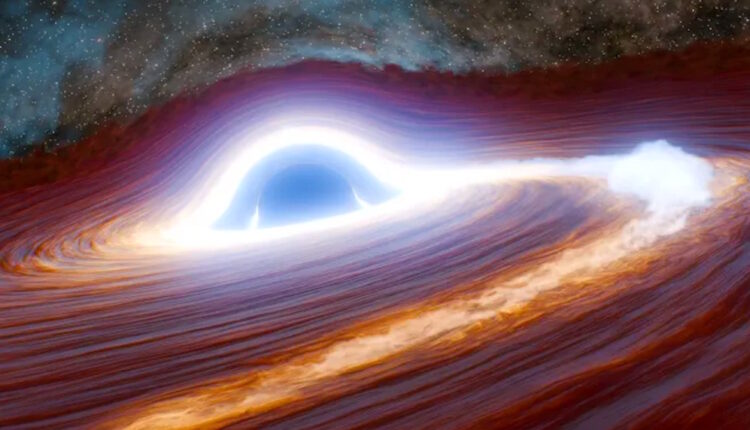In a record-breaking astronomical discovery, scientists have observed the most energetic flash of light ever detected, a cataclysmic flare from a supermassive black hole that briefly outshone the combined light of 10 trillion suns.
The phenomenal event, known as a tidal disruption event (TDE), was triggered when an unlucky star, many times the mass of our own sun, ventured too close to the black hole’s gravitational clutches. The findings, led by astronomer Matthew Graham of the California Institute of Technology (Caltech), were published on Tuesday in the journal Nature Astronomy.
A Star’s Violent Demise: The Physics of “Spaghettification”
The colossal burst of energy, designated AT2022cmc, was the death cry of a star being violently shredded and consumed.
“This was an exceptionally large star that wandered close enough to the supermassive black hole to be completely disrupted,” explained astronomer and study co-author KE Saavik Ford. “The immense gravity of the black hole, which strengthens drastically over short distances, stretched the star into a long, thin stream of gas in a process we call ‘spaghettification.’ That material then spiraled around the black hole at tremendous speeds as it fell in, heating up to millions of degrees and shining with an incredible intensity.”
The supermassive black hole at the heart of this event is a behemoth, estimated to be about 300 million times the mass of our sun. It resides in a galaxy so distant that its light has taken approximately 11 billion years to reach us, offering a window into the universe’s early epochs.
A Slow-Motion Cosmic Fireworks Display
First spotted in 2018 by the Zwicky Transient Facility (ZTF) at Caltech’s Palomar Observatory, this was no fleeting flash. The flare took about three months to reach its peak brightness, becoming roughly 30 times more luminous than any previously recorded TDE. The event is still ongoing but is now slowly fading, with astronomers predicting the entire process—from initial disruption to the final dimming of the accretion disk—will take about a decade to complete.
A Rare Glimpse into the Ancient Universe and Black Hole Jets
What makes this event particularly extraordinary is not just its raw power, but also its nature. Most TDEs are observed through optical or X-ray telescopes. AT2022cmc, however, was first detected as a brilliant flash of high-energy gamma-rays and later observed across the electromagnetic spectrum, from radio waves to X-rays.
This multi-wavelength signature indicates that the black hole did not just quietly consume the star. Instead, it launched a relativistic jet of material—a beam of plasma traveling at nearly the speed of light—directed almost straight toward Earth. The Doppler boosting of this jet, much like the intensified sound of a passing ambulance siren, is what amplified its brightness to such record-breaking levels.
“We are essentially looking down the barrel of this jet, which is why it appears so phenomenally bright to us,” said Dr. Graham. “This gives us a rare and invaluable opportunity to study the physics of these powerful jets, which are among the most energetic phenomena in the universe.”
Implications for Understanding the Cosmos
Almost every large galaxy, including our own Milky Way, harbors a supermassive black hole at its center. However, their formation and growth mechanisms remain one of the great mysteries of astrophysics.
Studying extreme events like AT2022cmc provides crucial clues. By observing how a black hole feeds and behaves during such a feast, scientists can better understand how these cosmic giants accumulate mass and influence the evolution of their host galaxies over billions of years. This single, brilliant flash from the distant past illuminates the fundamental, violent interactions that have shaped the cosmos we inhabit today.
Support Dawat Media Center
If there were ever a time to join us, it is now. Every contribution, however big or small, powers our journalism and sustains our future. Support the Dawat Media Center from as little as $/€10 – it only takes a minute. If you can, please consider supporting us with a regular amount each month. Thank you
DNB Bank AC # 0530 2294668
Account for international payments: NO15 0530 2294 668
Vipps: #557320
Support Dawat Media Center
If there were ever a time to join us, it is now. Every contribution, however big or small, powers our journalism and sustains our future. Support the Dawat Media Center from as little as $/€10 – it only takes a minute. If you can, please consider supporting us with a regular amount each month. Thank you
DNB Bank AC # 0530 2294668
Account for international payments: NO15 0530 2294 668
Vipps: #557320



Comments are closed.